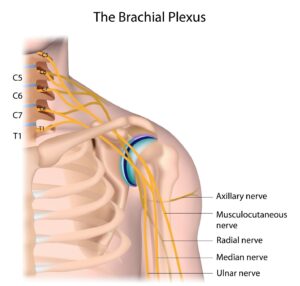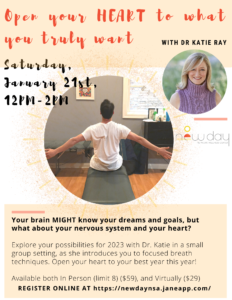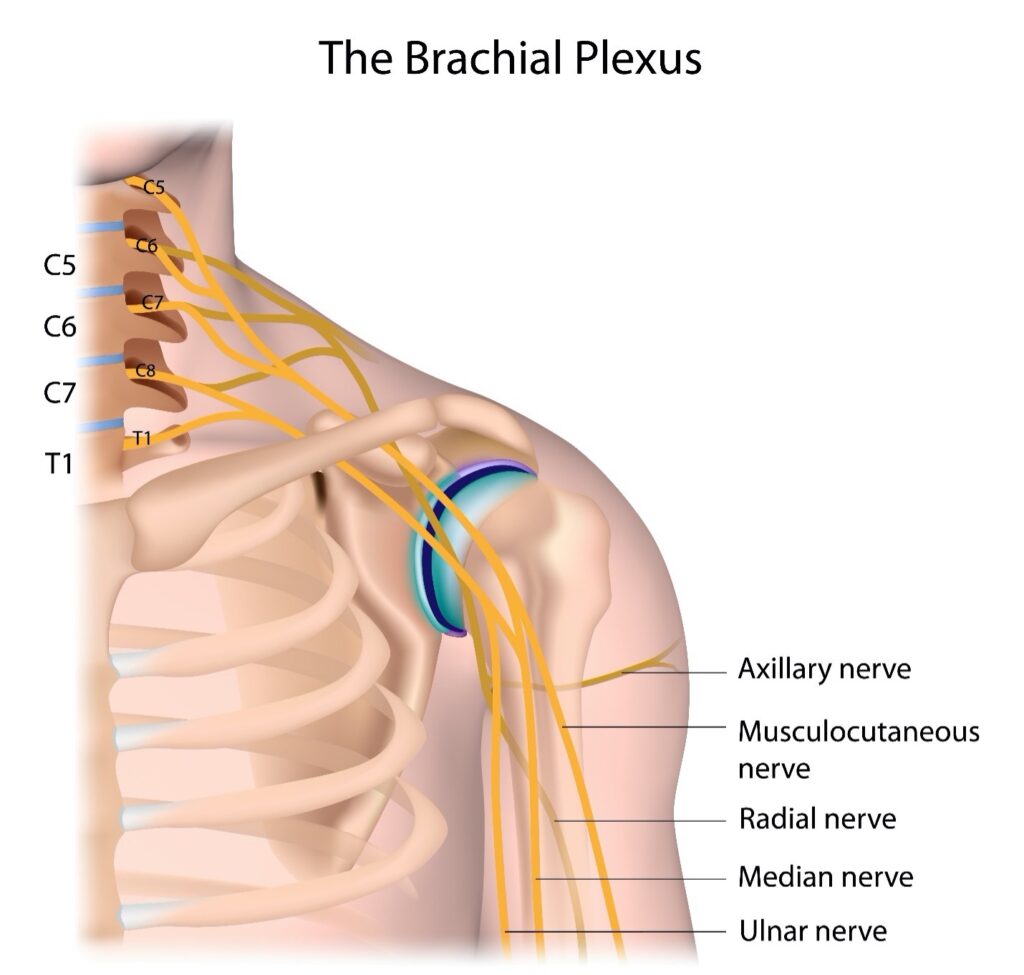Arm, shoulder, neck, hand, or wrist bothering you?

4 things to try
Good morning, sunshine-y New Day. Continued well-wishes and blessings to you and yours for your 2023 💥
Do you ever remember thinking, way back when you started care with me, “Soon, I won’t have any aches and pains at all, and then my life will be perfect!” 😰
Or maybe you’re new to Network Spinal and me right now, and you’re reading this now and thinking that you don’t like where I’m going with this 😂
Pain and discomfort are part of life. Pain is here to tell us that something needs to change– maybe it’s something as “simple” as our posture. But it could also be our diet, how we sit on the couch or in front of the computer, how much time we spend on our smart phone, our pillow, or any number of other things.
Or it could be something “deeper”– an emotional state (perhaps aided and abetted by the above-mentioned poor body postures, diets, and more), or a recurring thought pattern (also likely confounded by other variables).
But how do you know which it is? Wouldn’t it be great if your body would just “speak English” 😂🙏🏻😱
I consider myself fairly intuitive, but I’m not a psychic. And I can’t “control” your body any more than you can.
There is a reason though why most people receiving Network Spinal chiropractic care on a regular basis find that they have a lesser number of aches and pains, with a lesser severity, and that when they do have pain it tends to last less long than it used to.
I was thinking about this phenomenon a lot after the Intro to Care gathering at New Day this past Saturday, when I gathered with 6 newer members of our New Day community to discuss the what, how, and why of this life-changing care.
Even though your pain will never start “speaking English,” Network Spinal care helps people perceive, tune-into, or become aware of their pain and what’s causing it, and gives your nervous system tools (breath, movement, awareness) to change your pain like nothing else I’ve ever found in the world of healing. Practice members in care tend to feel more of a sense of ease in their bodies, and more peace of mind around what to do and how to focus when old or new issues flare up 💥💥💥
So that’s the good news. But what of stubborn, ongoing issues?

For some reason, I have noticed SO MANY of you lately with ongoing issues with a shoulder, arm, wrist, and/or hand (I am lumping them together because of how they are all related through the nerves).
Sometimes we might be tempted to say to ourselves, “Why is this still hurting? Why isn’t this care working anymore? I probably need (x,y,z other treatments and modalities).” Believe me, I’ve been there!
There are 2 guiding principles that I want you to keep in mind.
- In the body (and in life?), if a problem seems ongoing where you’re not getting a sense of progress or change, consider that this might be because there’s something about this problem that we haven’t yet grasped. It’s like a phone that’s ringing, and ringing. It’s going to keep ringing until we get the message ☎️
- You might have heard me say it before, but I’ve heard it said that “when you’re ready for the truth, you could find it in a phone book.” Basically, the answer/s that will give us the breakthrough might be right in front of us, but we need to be READY to receive the message. During or after your adjustments, and or your other healthy routines (meditating, yoga, etc) are times when you are most likely to receive that message 💥✨
When it comes to shoulder, arm, hand, and wrist pain, there are 4 things I want you to try. Maybe one or more of them will be part of the solution you’ve been waiting for.
Where are you looking?
It’s shocking, really, how much time we spend looking down. I see it at the gym– people are on treadmills with their airpods in, looking at a video on their phone, but the problem is that their phone is sitting down in front of them at chest-level!
I see it with people sitting on couches, phone in hand and in some cases even propped up against their midsection (!) as they scroll 😱
Unless you are looking STRAIGHT OUT IN FRONT OF YOU, even better perhaps, slightly up and out, you are putting pressure on the discs in your spine and all the nerves that are running to and from your spine, trying to communicate. Your neck and shoulders disproportionately bear the brunt of this.
Prove it to yourself by trying this experiment. Place your fingers lightly on the back of your head, right in the spot where your neck is ending and your scull is beginning (your fingers should be on your scalp in your hair). Now, keeping your fingers in place and sitting up straight with good posture, look DOWN with your eyeballs. Then look up and out in front of you.
Repeat the looking down and looking out and FEEL how when you look down with your eyeballs, even with otherwise good posture, the muscles tense up. That’s your nervous system letting your muscles know that they need to protect your spine from the damage that will occur should you continue to look down.

As it has been researched and proven, it only takes a dime’s worth of pressure on a nerve to change the signals being sent.
Challenge yourself in your work to stay looking straight out, and slightly up, as much of the day as possible. Adjust your computer monitor accordingly and DO NOT work for any long period of time (over 10 minutes) on your phone.
What’s your pillow situation?
Is your pillow too puffy? I really think pillows that elevate the head and neck to such an extent that the shoulders are being pulled forward as you sleep are a widespread problem. Waking up with stiffness in the head, neck, and shoulders, and/or aching, numbness, and tingling in the arms when trying to sleep may indicate your pillow is too puffy.
If this is your problem, here is what I want you to try. Go a night or two with no pillow at all.
Just sleep with your head directly on the mattress. Sleep on your back with your arms gently resting at your sides. It is best if you can try this on a night when you are very tired to increase the likelihood that you will be able to sleep for at least a little while in the new position.
I’m not necessarily advising you to do this permanently– simply try it for a night or two and see if it’s enough of a pattern interruption for you to make some progress on your issues. After that, check in with what you feel. Then you can decide if you want to continue longer with no pillow, the same pillow, a new pillow, or switching it up night by night.
Is your heart open?
As most people know, a sharp, crushing arm and shoulder pain accompanied by racing heart, cold sweat, shortness of breath, etc, are signs of a possible heart attack.
I’m not sharing this to scare you. If you’re having an ongoing, chronic issue with aches and pains in the shoulder and arm, you are most likely not also having a heart attack.
But the reason I point this out is to remind you of the connection between our internal organs and our musculoskeletal system.
One of the major things that Network Spinal care impacts is the fight or flight nervous system– the response to perceived stress that tightens your muscles, and creates a rigid, protective, defensive posture. Are your tight shoulders and arms actually your nervous system protecting you and your heart?
Try this experiment. Every time you notice your neck, shoulder/s, arms, wrists or hands bothering you, instead of focusing on trying to make it go away, INSTEAD focus on breathing and sending energy and focus into your heart. What if your heart had more room to expand front to back , side to side, or on a diagonal? Picture it as you breathe. Now, check on your shoulders. Do they feel more relaxed?
Go deeper with me.

I hope there was at least one little nugget in here that was something you needed to read today and can take with you into your week 💎💥💗✨
I feel so inspired to help us tune in to our hearts and open them even more, that I am offering an in-depth breathwork experience with me NEXT Saturday the 21st. There will be a live, in-person class at New Day (limited to 8 participants), and a virtual class for those who would rather attend remotely.
As you may already know, Donny Epstein, creator of Network Spinal care, also created a special breathwork modality. I specialize in facilitating a version of that work, which I call Focused Breath. This work helps your nervous system in some of the same ways that the care you get on the adjusting table will do.
I will talk more about this over the next week and a half. You can register here.
In the meantime, I look forward to seeing you for your care at New Day this week 💖


